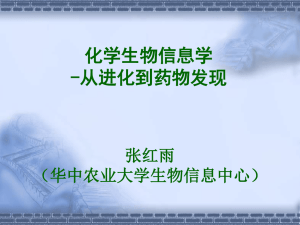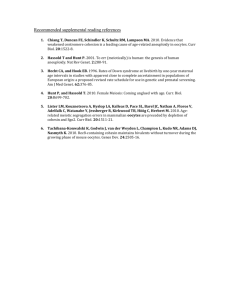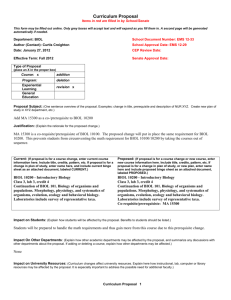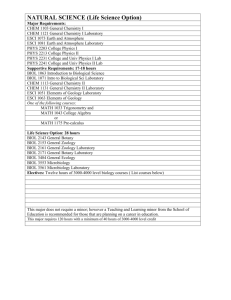Table S1. Cellular functions of non
advertisement
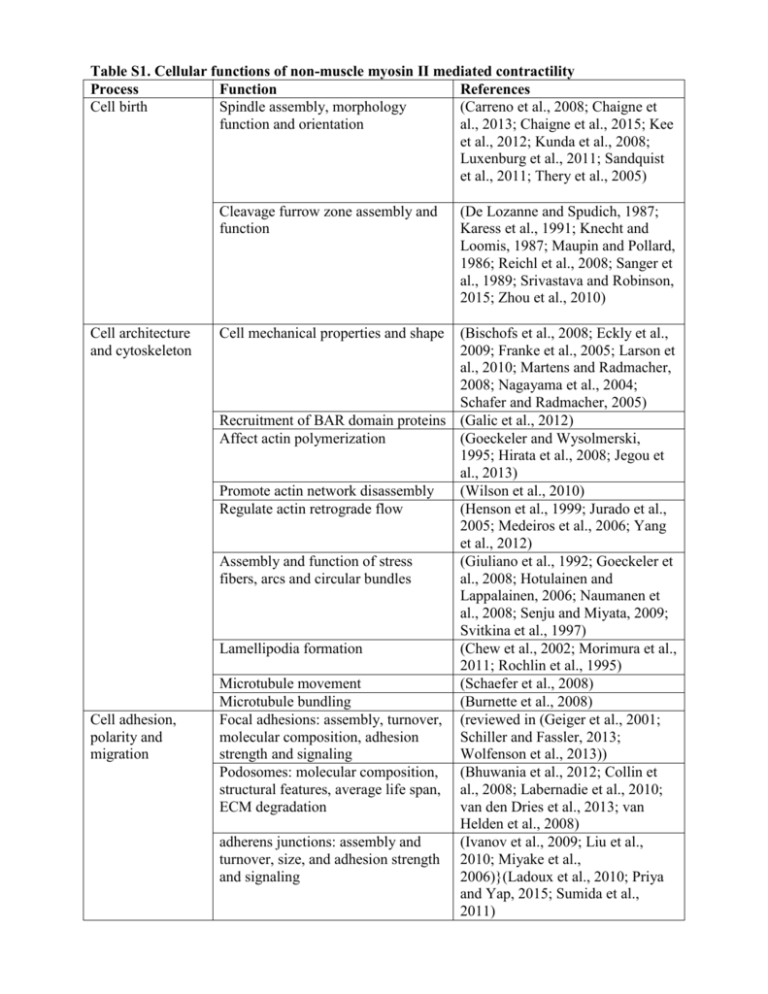
Table S1. Cellular functions of non-muscle myosin II mediated contractility Process Function References Cell birth Spindle assembly, morphology (Carreno et al., 2008; Chaigne et function and orientation al., 2013; Chaigne et al., 2015; Kee et al., 2012; Kunda et al., 2008; Luxenburg et al., 2011; Sandquist et al., 2011; Thery et al., 2005) Cleavage furrow zone assembly and function Cell architecture and cytoskeleton Cell adhesion, polarity and migration Cell mechanical properties and shape (De Lozanne and Spudich, 1987; Karess et al., 1991; Knecht and Loomis, 1987; Maupin and Pollard, 1986; Reichl et al., 2008; Sanger et al., 1989; Srivastava and Robinson, 2015; Zhou et al., 2010) (Bischofs et al., 2008; Eckly et al., 2009; Franke et al., 2005; Larson et al., 2010; Martens and Radmacher, 2008; Nagayama et al., 2004; Schafer and Radmacher, 2005) Recruitment of BAR domain proteins (Galic et al., 2012) Affect actin polymerization (Goeckeler and Wysolmerski, 1995; Hirata et al., 2008; Jegou et al., 2013) Promote actin network disassembly (Wilson et al., 2010) Regulate actin retrograde flow (Henson et al., 1999; Jurado et al., 2005; Medeiros et al., 2006; Yang et al., 2012) Assembly and function of stress (Giuliano et al., 1992; Goeckeler et fibers, arcs and circular bundles al., 2008; Hotulainen and Lappalainen, 2006; Naumanen et al., 2008; Senju and Miyata, 2009; Svitkina et al., 1997) Lamellipodia formation (Chew et al., 2002; Morimura et al., 2011; Rochlin et al., 1995) Microtubule movement (Schaefer et al., 2008) Microtubule bundling (Burnette et al., 2008) Focal adhesions: assembly, turnover, (reviewed in (Geiger et al., 2001; molecular composition, adhesion Schiller and Fassler, 2013; strength and signaling Wolfenson et al., 2013)) Podosomes: molecular composition, (Bhuwania et al., 2012; Collin et structural features, average life span, al., 2008; Labernadie et al., 2010; ECM degradation van den Dries et al., 2013; van Helden et al., 2008) adherens junctions: assembly and (Ivanov et al., 2009; Liu et al., turnover, size, and adhesion strength 2010; Miyake et al., and signaling 2006)}(Ladoux et al., 2010; Priya and Yap, 2015; Sumida et al., 2011) Tight junctions: assembly and turnover Tunneling nanotubes (TNT) Apicobasal polarity Planar cell polarity Cell polarization under flow, substrate stretching, chemical gradients, electric fields Cell migration Endoplasmic organization and trafficking Endoplasmic spreading Phagocytic cup assembly, squeezing and closure Clathrin-mediated endocytosis Exocytosis ER stress Golgi architecture and dynamics Cell fusion Cell environment Membrane fusion Transport of ECM components ECM assembly ECM remodeling ECM proteolytic degradation Topography and stiffness sensing Cell signaling Exposing cryptic sites and changing the conformation of: ECM proteins, signaling proteins, enzymes, ion channels Receptor localization Receptor internalization Nucleus motility and positioning Nucleus morphology and stiffness Histone acetylation Chromatin condensation DNA synthesis Gene expression Cell proliferation and differentiation Nucleus and nuclear activity Cell Infection Bacteria and viruses invasion (Ivanov et al., 2009; Miyake et al., 2006) (Gurke et al., 2008) (Yu et al., 2008) (Lee et al., 2012; Walters et al., 2006) (Goldyn et al., 2010; Liu et al., 2014; Sun et al., 2013; Tkachenko et al., 2013) (Aguilar-Cuenca et al., 2014; Vicente-Manzanares et al., 2009; Yam et al., 2007) (Lynch et al., 2013) (Olazabal et al., 2002) (Chandrasekar et al., 2014; Chandrasekar et al., 2013) (Masedunskas et al., 2012; Masedunskas et al., 2011; Nightingale et al., 2011) (He et al., 2012) (Guet et al., 2014; Zilberman et al., 2011) (Kim et al., 2015) (Kalson et al., 2013) (Zhang et al., 1997) (Bloom et al., 2008) (Kirmse et al., 2011) (Ghibaudo et al., 2009; Ozdemir et al., 2013) (Iskratsch et al., 2014; Vogel and Sheetz, 2006) (Salaita et al., 2010) (Rey et al., 2007; Rey et al., 2002) (Goulding et al., 2007) (Guilluy et al., 2014) (Kim et al., 2005) (Song et al., 2002) (Tanaka et al., 2009) (Hossain et al., 2006) (Chowdhury et al., 2010; Ozdemir et al., 2013; Rottmar et al., 2014; Tanaka et al., 2009) (Hanisch et al., 2011; Hanisch et al., 2012; Lehmann et al., 2005; Rajabian et al., 2009; van Leeuwen et al., 2002) Bacteria dissemination Cell death/survival Apototic cell compaction and detachment Release of nuclear RanGTP E4orf4 mediated cell death Entosis Cell survival (Rajabian et al., 2009) (Solinet and Vitale, 2008) (Moss et al., 2009) (Smadja-Lamere et al., 2008) (Overholtzer et al., 2007) (Chen et al., 2010; Connell and Helfman, 2006) References Aguilar-Cuenca, R., Juanes-Garcia, A. and Vicente-Manzanares, M. (2014). Myosin II in mechanotransduction: master and commander of cell migration, morphogenesis, and cancer. Cell Mol Life Sci 71, 479-92. Bhuwania, R., Cornfine, S., Fang, Z., Kruger, M., Luna, E. J. and Linder, S. (2012). Supervillin couples myosin-dependent contractility to podosomes and enables their turnover. J Cell Sci 125, 2300-14. Bischofs, I. B., Klein, F., Lehnert, D., Bastmeyer, M. and Schwarz, U. S. (2008). Filamentous network mechanics and active contractility determine cell and tissue shape. Biophys J 95, 3488-96. Bloom, R. J., George, J. P., Celedon, A., Sun, S. X. and Wirtz, D. (2008). Mapping local matrix remodeling induced by a migrating tumor cell using three-dimensional multiple-particle tracking. Biophys J 95, 4077-88. Burnette, D. T., Ji, L., Schaefer, A. W., Medeiros, N. A., Danuser, G. and Forscher, P. (2008). Myosin II activity facilitates microtubule bundling in the neuronal growth cone neck. Dev Cell 15, 163-9. Carreno, S., Kouranti, I., Glusman, E. S., Fuller, M. T., Echard, A. and Payre, F. (2008). Moesin and its activating kinase Slik are required for cortical stability and microtubule organization in mitotic cells. J Cell Biol 180, 739-46. Chaigne, A., Campillo, C., Gov, N. S., Voituriez, R., Azoury, J., Umana-Diaz, C., Almonacid, M., Queguiner, I., Nassoy, P., Sykes, C. et al. (2013). A soft cortex is essential for asymmetric spindle positioning in mouse oocytes. Nat Cell Biol 15, 958-66. Chaigne, A., Campillo, C., Gov, N. S., Voituriez, R., Sykes, C., Verlhac, M. H. and Terret, M. E. (2015). A narrow window of cortical tension guides asymmetric spindle positioning in the mouse oocyte. Nat Commun 6, 6027. Chandrasekar, I., Goeckeler, Z. M., Turney, S. G., Wang, P., Wysolmerski, R. B., Adelstein, R. S. and Bridgman, P. C. (2014). Nonmuscle myosin II is a critical regulator of clathrin-mediated endocytosis. Traffic 15, 418-32. Chandrasekar, I., Huettner, J. E., Turney, S. G. and Bridgman, P. C. (2013). Myosin II regulates activity dependent compensatory endocytosis at central synapses. J Neurosci 33, 16131-45. Chen, G., Hou, Z., Gulbranson, D. R. and Thomson, J. A. (2010). Actin-myosin contractility is responsible for the reduced viability of dissociated human embryonic stem cells. Cell Stem Cell 7, 240-8. Chew, T. L., Wolf, W. A., Gallagher, P. J., Matsumura, F. and Chisholm, R. L. (2002). A fluorescent resonant energy transfer-based biosensor reveals transient and regional myosin light chain kinase activation in lamella and cleavage furrows. J Cell Biol 156, 543-53. Chowdhury, F., Na, S., Li, D., Poh, Y. C., Tanaka, T. S., Wang, F. and Wang, N. (2010). Material properties of the cell dictate stress-induced spreading and differentiation in embryonic stem cells. Nat Mater 9, 82-8. Collin, O., Na, S., Chowdhury, F., Hong, M., Shin, M. E., Wang, F. and Wang, N. (2008). Self-organized podosomes are dynamic mechanosensors. Curr Biol 18, 1288-94. Connell, L. E. and Helfman, D. M. (2006). Myosin light chain kinase plays a role in the regulation of epithelial cell survival. J Cell Sci 119, 2269-81. De Lozanne, A. and Spudich, J. A. (1987). Disruption of the Dictyostelium myosin heavy chain gene by homologous recombination. Science 236, 1086-91. Eckly, A., Strassel, C., Freund, M., Cazenave, J. P., Lanza, F., Gachet, C. and Leon, C. (2009). Abnormal megakaryocyte morphology and proplatelet formation in mice with megakaryocyte-restricted MYH9 inactivation. Blood 113, 3182-9. Franke, J. D., Montague, R. A. and Kiehart, D. P. (2005). Nonmuscle myosin II generates forces that transmit tension and drive contraction in multiple tissues during dorsal closure. Curr Biol 15, 2208-21. Galic, M., Jeong, S., Tsai, F. C., Joubert, L. M., Wu, Y. I., Hahn, K. M., Cui, Y. and Meyer, T. (2012). External push and internal pull forces recruit curvature-sensing N-BAR domain proteins to the plasma membrane. Nat Cell Biol 14, 874-81. Geiger, B., Bershadsky, A., Pankov, R. and Yamada, K. M. (2001). Transmembrane crosstalk between the extracellular matrix--cytoskeleton crosstalk. Nat Rev Mol Cell Biol 2, 793-805. Ghibaudo, M., Trichet, L., Le Digabel, J., Richert, A., Hersen, P. and Ladoux, B. (2009). Substrate topography induces a crossover from 2D to 3D behavior in fibroblast migration. Biophys J 97, 357-68. Giuliano, K. A., Kolega, J., DeBiasio, R. L. and Taylor, D. L. (1992). Myosin II phosphorylation and the dynamics of stress fibers in serum-deprived and stimulated fibroblasts. Mol Biol Cell 3, 1037-48. Goeckeler, Z. M., Bridgman, P. C. and Wysolmerski, R. B. (2008). Nonmuscle myosin II is responsible for maintaining endothelial cell basal tone and stress fiber integrity. Am J Physiol Cell Physiol 295, C994-1006. Goeckeler, Z. M. and Wysolmerski, R. B. (1995). Myosin light chain kinaseregulated endothelial cell contraction: the relationship between isometric tension, actin polymerization, and myosin phosphorylation. J Cell Biol 130, 613-27. Goldyn, A. M., Kaiser, P., Spatz, J. P., Ballestrem, C. and Kemkemer, R. (2010). The kinetics of force-induced cell reorganization depend on microtubules and actin. Cytoskeleton (Hoboken) 67, 241-50. Goulding, M. B., Canman, J. C., Senning, E. N., Marcus, A. H. and Bowerman, B. (2007). Control of nuclear centration in the C. elegans zygote by receptor-independent Galpha signaling and myosin II. J Cell Biol 178, 1177-91. Guet, D., Mandal, K., Pinot, M., Hoffmann, J., Abidine, Y., Sigaut, W., Bardin, S., Schauer, K., Goud, B. and Manneville, J. B. (2014). Mechanical Role of Actin Dynamics in the Rheology of the Golgi Complex and in Golgi-Associated Trafficking Events. Curr Biol. Guilluy, C., Osborne, L. D., Van Landeghem, L., Sharek, L., Superfine, R., GarciaMata, R. and Burridge, K. (2014). Isolated nuclei adapt to force and reveal a mechanotransduction pathway in the nucleus. Nat Cell Biol 16, 376-81. Gurke, S., Barroso, J. F., Hodneland, E., Bukoreshtliev, N. V., Schlicker, O. and Gerdes, H. H. (2008). Tunneling nanotube (TNT)-like structures facilitate a constitutive, actomyosin-dependent exchange of endocytic organelles between normal rat kidney cells. Exp Cell Res 314, 3669-83. Hanisch, J., Kolm, R., Wozniczka, M., Bumann, D., Rottner, K. and Stradal, T. E. (2011). Activation of a RhoA/myosin II-dependent but Arp2/3 complex-independent pathway facilitates Salmonella invasion. Cell Host Microbe 9, 273-85. Hanisch, J., Stradal, T. E. and Rottner, K. (2012). A novel contractility pathway operating in Salmonella invasion. Virulence 3, 81-6. He, Y., Beatty, A., Han, X., Ji, Y., Ma, X., Adelstein, R. S., Yates, J. R., 3rd, Kemphues, K. and Qi, L. (2012). Nonmuscle myosin IIB links cytoskeleton to IRE1alpha signaling during ER stress. Dev Cell 23, 1141-52. Henson, J. H., Svitkina, T. M., Burns, A. R., Hughes, H. E., MacPartland, K. J., Nazarian, R. and Borisy, G. G. (1999). Two components of actin-based retrograde flow in sea urchin coelomocytes. Mol Biol Cell 10, 4075-90. Hirata, H., Tatsumi, H. and Sokabe, M. (2008). Mechanical forces facilitate actin polymerization at focal adhesions in a zyxin-dependent manner. J Cell Sci 121, 2795-804. Hossain, M. M., Smith, P. G., Wu, K. and Jin, J. P. (2006). Cytoskeletal tension regulates both expression and degradation of h2-calponin in lung alveolar cells. Biochemistry 45, 15670-83. Hotulainen, P. and Lappalainen, P. (2006). Stress fibers are generated by two distinct actin assembly mechanisms in motile cells. J Cell Biol 173, 383-94. Iskratsch, T., Wolfenson, H. and Sheetz, M. P. (2014). Appreciating force and shape-the rise of mechanotransduction in cell biology. Nat Rev Mol Cell Biol 15, 825-33. Ivanov, A. I., Samarin, S. N., Bachar, M., Parkos, C. A. and Nusrat, A. (2009). Protein kinase C activation disrupts epithelial apical junctions via ROCK-II dependent stimulation of actomyosin contractility. BMC Cell Biol 10, 36. Jegou, A., Carlier, M. F. and Romet-Lemonne, G. (2013). Formin mDia1 senses and generates mechanical forces on actin filaments. Nat Commun 4, 1883. Jurado, C., Haserick, J. R. and Lee, J. (2005). Slipping or gripping? Fluorescent speckle microscopy in fish keratocytes reveals two different mechanisms for generating a retrograde flow of actin. Mol Biol Cell 16, 507-18. Kalson, N. S., Starborg, T., Lu, Y., Mironov, A., Humphries, S. M., Holmes, D. F. and Kadler, K. E. (2013). Nonmuscle myosin II powered transport of newly formed collagen fibrils at the plasma membrane. Proc Natl Acad Sci U S A 110, E4743-52. Karess, R. E., Chang, X. J., Edwards, K. A., Kulkarni, S., Aguilera, I. and Kiehart, D. P. (1991). The regulatory light chain of nonmuscle myosin is encoded by spaghettisquash, a gene required for cytokinesis in Drosophila. Cell 65, 1177-89. Kee, Y. S., Ren, Y., Dorfman, D., Iijima, M., Firtel, R., Iglesias, P. A. and Robinson, D. N. (2012). A mechanosensory system governs myosin II accumulation in dividing cells. Mol Biol Cell 23, 1510-23. Kim, J. H., Ren, Y., Ng, W. P., Li, S., Son, S., Kee, Y. S., Zhang, S., Zhang, G., Fletcher, D. A., Robinson, D. N. et al. (2015). Mechanical tension drives cell membrane fusion. Dev Cell 32, 561-73. Kim, Y. B., Yu, J., Lee, S. Y., Lee, M. S., Ko, S. G., Ye, S. K., Jong, H. S., Kim, T. Y., Bang, Y. J. and Lee, J. W. (2005). Cell adhesion status-dependent histone acetylation is regulated through intracellular contractility-related signaling activities. J Biol Chem 280, 28357-64. Kirmse, R., Otto, H. and Ludwig, T. (2011). Interdependency of cell adhesion, force generation and extracellular proteolysis in matrix remodeling. J Cell Sci 124, 1857-66. Knecht, D. A. and Loomis, W. F. (1987). Antisense RNA inactivation of myosin heavy chain gene expression in Dictyostelium discoideum. Science 236, 1081-6. Kunda, P., Pelling, A. E., Liu, T. and Baum, B. (2008). Moesin controls cortical rigidity, cell rounding, and spindle morphogenesis during mitosis. Curr Biol 18, 91-101. Labernadie, A., Thibault, C., Vieu, C., Maridonneau-Parini, I. and Charriere, G. M. (2010). Dynamics of podosome stiffness revealed by atomic force microscopy. Proc Natl Acad Sci U S A 107, 21016-21. Ladoux, B., Anon, E., Lambert, M., Rabodzey, A., Hersen, P., Buguin, A., Silberzan, P. and Mege, R. M. (2010). Strength dependence of cadherin-mediated adhesions. Biophys J 98, 534-42. Larson, S. M., Lee, H. J., Hung, P. H., Matthews, L. M., Robinson, D. N. and Evans, J. P. (2010). Cortical mechanics and meiosis II completion in mammalian oocytes are mediated by myosin-II and Ezrin-Radixin-Moesin (ERM) proteins. Mol Biol Cell 21, 318292. Lee, J., Andreeva, A., Sipe, C. W., Liu, L., Cheng, A. and Lu, X. (2012). PTK7 regulates myosin II activity to orient planar polarity in the mammalian auditory epithelium. Curr Biol 22, 956-66. Lehmann, M. J., Sherer, N. M., Marks, C. B., Pypaert, M. and Mothes, W. (2005). Actin- and myosin-driven movement of viruses along filopodia precedes their entry into cells. J Cell Biol 170, 317-25. Liu, L., Gritz, D. and Parent, C. A. (2014). PKCbetaII acts downstream of chemoattractant receptors and mTORC2 to regulate cAMP production and myosin II activity in neutrophils. Mol Biol Cell 25, 1446-57. Liu, Z., Tan, J. L., Cohen, D. M., Yang, M. T., Sniadecki, N. J., Ruiz, S. A., Nelson, C. M. and Chen, C. S. (2010). Mechanical tugging force regulates the size of cell-cell junctions. Proc Natl Acad Sci U S A 107, 9944-9. Luxenburg, C., Pasolli, H. A., Williams, S. E. and Fuchs, E. (2011). Developmental roles for Srf, cortical cytoskeleton and cell shape in epidermal spindle orientation. Nat Cell Biol 13, 203-14. Lynch, C. D., Lazar, A. M., Iskratsch, T., Zhang, X. and Sheetz, M. P. (2013). Endoplasmic spreading requires coalescence of vimentin intermediate filaments at forcebearing adhesions. Mol Biol Cell 24, 21-30. Martens, J. C. and Radmacher, M. (2008). Softening of the actin cytoskeleton by inhibition of myosin II. Pflugers Arch 456, 95-100. Masedunskas, A., Porat-Shliom, N. and Weigert, R. (2012). Linking differences in membrane tension with the requirement for a contractile actomyosin scaffold during exocytosis in salivary glands. Commun Integr Biol 5, 84-7. Masedunskas, A., Sramkova, M., Parente, L., Sales, K. U., Amornphimoltham, P., Bugge, T. H. and Weigert, R. (2011). Role for the actomyosin complex in regulated exocytosis revealed by intravital microscopy. Proc Natl Acad Sci U S A 108, 13552-7. Maupin, P. and Pollard, T. D. (1986). Arrangement of actin filaments and myosinlike filaments in the contractile ring and of actin-like filaments in the mitotic spindle of dividing HeLa cells. J Ultrastruct Mol Struct Res 94, 92-103. Medeiros, N. A., Burnette, D. T. and Forscher, P. (2006). Myosin II functions in actin-bundle turnover in neuronal growth cones. Nat Cell Biol 8, 215-26. Miyake, Y., Inoue, N., Nishimura, K., Kinoshita, N., Hosoya, H. and Yonemura, S. (2006). Actomyosin tension is required for correct recruitment of adherens junction components and zonula occludens formation. Exp Cell Res 312, 1637-50. Morimura, S., Suzuki, K. and Takahashi, K. (2011). Nonmuscle myosin IIA is required for lamellipodia formation through binding to WAVE2 and phosphatidylinositol 3,4,5-triphosphate. Biochem Biophys Res Commun 404, 834-40. Moss, D. K., Wilde, A. and Lane, J. D. (2009). Dynamic release of nuclear RanGTP triggers TPX2-dependent microtubule assembly during the apoptotic execution phase. J Cell Sci 122, 644-55. Nagayama, M., Haga, H., Takahashi, M., Saitoh, T. and Kawabata, K. (2004). Contribution of cellular contractility to spatial and temporal variations in cellular stiffness. Exp Cell Res 300, 396-405. Naumanen, P., Lappalainen, P. and Hotulainen, P. (2008). Mechanisms of actin stress fibre assembly. J Microsc 231, 446-54. Nightingale, T. D., White, I. J., Doyle, E. L., Turmaine, M., Harrison-Lavoie, K. J., Webb, K. F., Cramer, L. P. and Cutler, D. F. (2011). Actomyosin II contractility expels von Willebrand factor from Weibel-Palade bodies during exocytosis. J Cell Biol 194, 613-29. Olazabal, I. M., Caron, E., May, R. C., Schilling, K., Knecht, D. A. and Machesky, L. M. (2002). Rho-kinase and myosin-II control phagocytic cup formation during CR, but not FcgammaR, phagocytosis. Curr Biol 12, 1413-18. Overholtzer, M., Mailleux, A. A., Mouneimne, G., Normand, G., Schnitt, S. J., King, R. W., Cibas, E. S. and Brugge, J. S. (2007). A nonapoptotic cell death process, entosis, that occurs by cell-in-cell invasion. Cell 131, 966-79. Ozdemir, T., Xu, L. C., Siedlecki, C. and Brown, J. L. (2013). Substrate curvature sensing through Myosin IIa upregulates early osteogenesis. Integr Biol (Camb) 5, 1407-16. Priya, R. and Yap, A. S. (2015). Active tension: the role of cadherin adhesion and signaling in generating junctional contractility. Curr Top Dev Biol 112, 65-102. Rajabian, T., Gavicherla, B., Heisig, M., Muller-Altrock, S., Goebel, W., GrayOwen, S. D. and Ireton, K. (2009). The bacterial virulence factor InlC perturbs apical cell junctions and promotes cell-to-cell spread of Listeria. Nat Cell Biol 11, 1212-8. Reichl, E. M., Ren, Y., Morphew, M. K., Delannoy, M., Effler, J. C., Girard, K. D., Divi, S., Iglesias, P. A., Kuo, S. C. and Robinson, D. N. (2008). Interactions between myosin and actin crosslinkers control cytokinesis contractility dynamics and mechanics. Curr Biol 18, 471-80. Rey, M., Valenzuela-Fernandez, A., Urzainqui, A., Yanez-Mo, M., Perez-Martinez, M., Penela, P., Mayor, F., Jr. and Sanchez-Madrid, F. (2007). Myosin IIA is involved in the endocytosis of CXCR4 induced by SDF-1alpha. J Cell Sci 120, 1126-33. Rey, M., Vicente-Manzanares, M., Viedma, F., Yanez-Mo, M., Urzainqui, A., Barreiro, O., Vazquez, J. and Sanchez-Madrid, F. (2002). Cutting edge: association of the motor protein nonmuscle myosin heavy chain-IIA with the C terminus of the chemokine receptor CXCR4 in T lymphocytes. J Immunol 169, 5410-4. Rochlin, M. W., Itoh, K., Adelstein, R. S. and Bridgman, P. C. (1995). Localization of myosin II A and B isoforms in cultured neurons. J Cell Sci 108 ( Pt 12), 3661-70. Rottmar, M., Mhanna, R., Guimond-Lischer, S., Vogel, V., Zenobi-Wong, M. and Maniura-Weber, K. (2014). Interference with the contractile machinery of the fibroblastic chondrocyte cytoskeleton induces re-expression of the cartilage phenotype through involvement of PI3K, PKC and MAPKs. Exp Cell Res 320, 175-87. Salaita, K., Nair, P. M., Petit, R. S., Neve, R. M., Das, D., Gray, J. W. and Groves, J. T. (2010). Restriction of receptor movement alters cellular response: physical force sensing by EphA2. Science 327, 1380-5. Sandquist, J. C., Kita, A. M. and Bement, W. M. (2011). And the dead shall rise: actin and myosin return to the spindle. Dev Cell 21, 410-9. Sanger, J. M., Mittal, B., Dome, J. S. and Sanger, J. W. (1989). Analysis of cell division using fluorescently labeled actin and myosin in living PtK2 cells. Cell Motil Cytoskeleton 14, 201-19. Schaefer, A. W., Schoonderwoert, V. T., Ji, L., Mederios, N., Danuser, G. and Forscher, P. (2008). Coordination of actin filament and microtubule dynamics during neurite outgrowth. Dev Cell 15, 146-62. Schafer, A. and Radmacher, M. (2005). Influence of myosin II activity on stiffness of fibroblast cells. Acta Biomater 1, 273-80. Schiller, H. B. and Fassler, R. (2013). Mechanosensitivity and compositional dynamics of cell-matrix adhesions. EMBO Rep 14, 509-19. Senju, Y. and Miyata, H. (2009). The role of actomyosin contractility in the formation and dynamics of actin bundles during fibroblast spreading. J Biochem 145, 13750. Smadja-Lamere, N., Boulanger, M. C., Champagne, C., Branton, P. E. and Lavoie, J. N. (2008). JNK-mediated phosphorylation of paxillin in adhesion assembly and tensioninduced cell death by the adenovirus death factor E4orf4. J Biol Chem 283, 34352-64. Solinet, S. and Vitale, M. L. (2008). Isoform B of myosin II heavy chain mediates actomyosin contractility during TNFalpha-induced apoptosis. J Cell Sci 121, 1681-92. Song, Y., Hoang, B. Q. and Chang, D. D. (2002). ROCK-II-induced membrane blebbing and chromatin condensation require actin cytoskeleton. Exp Cell Res 278, 45-52. Srivastava, V. and Robinson, D. N. (2015). Mechanical Stress and Network Structure Drive Protein Dynamics during Cytokinesis. Curr Biol 25, 663-70. Sumida, G. M., Tomita, T. M., Shih, W. and Yamada, S. (2011). Myosin II activity dependent and independent vinculin recruitment to the sites of E-cadherin-mediated cellcell adhesion. BMC Cell Biol 12, 48. Sun, Y., Do, H., Gao, J., Zhao, R., Zhao, M. and Mogilner, A. (2013). Keratocyte fragments and cells utilize competing pathways to move in opposite directions in an electric field. Curr Biol 23, 569-74. Svitkina, T. M., Verkhovsky, A. B., McQuade, K. M. and Borisy, G. G. (1997). Analysis of the actin-myosin II system in fish epidermal keratocytes: mechanism of cell body translocation. J Cell Biol 139, 397-415. Tanaka, M., Abe, T. and Hara, Y. (2009). Roles of focal adhesions and fibronectinmediated cohesion in proliferation of confluent fibroblasts. J Cell Physiol 219, 194-201. Thery, M., Racine, V., Pepin, A., Piel, M., Chen, Y., Sibarita, J. B. and Bornens, M. (2005). The extracellular matrix guides the orientation of the cell division axis. Nat Cell Biol 7, 947-53. Tkachenko, E., Gutierrez, E., Saikin, S. K., Fogelstrand, P., Kim, C., Groisman, A. and Ginsberg, M. H. (2013). The nucleus of endothelial cell as a sensor of blood flow direction. Biol Open 2, 1007-12. van den Dries, K., Meddens, M. B., de Keijzer, S., Shekhar, S., Subramaniam, V., Figdor, C. G. and Cambi, A. (2013). Interplay between myosin IIA-mediated contractility and actin network integrity orchestrates podosome composition and oscillations. Nat Commun 4, 1412. van Helden, S. F., Oud, M. M., Joosten, B., Peterse, N., Figdor, C. G. and van Leeuwen, F. N. (2008). PGE2-mediated podosome loss in dendritic cells is dependent on actomyosin contraction downstream of the RhoA-Rho-kinase axis. J Cell Sci 121, 1096-106. van Leeuwen, H., Elliott, G. and O'Hare, P. (2002). Evidence of a role for nonmuscle myosin II in herpes simplex virus type 1 egress. J Virol 76, 3471-81. Vicente-Manzanares, M., Ma, X., Adelstein, R. S. and Horwitz, A. R. (2009). Nonmuscle myosin II takes centre stage in cell adhesion and migration. Nat Rev Mol Cell Biol 10, 778-90. Vogel, V. and Sheetz, M. (2006). Local force and geometry sensing regulate cell functions. Nat Rev Mol Cell Biol 7, 265-75. Walters, J. W., Dilks, S. A. and DiNardo, S. (2006). Planar polarization of the denticle field in the Drosophila embryo: roles for Myosin II (zipper) and fringe. Dev Biol 297, 323-39. Wilson, C. A., Tsuchida, M. A., Allen, G. M., Barnhart, E. L., Applegate, K. T., Yam, P. T., Ji, L., Keren, K., Danuser, G. and Theriot, J. A. (2010). Myosin II contributes to cellscale actin network treadmilling through network disassembly. Nature 465, 373-7. Wolfenson, H., Lavelin, I. and Geiger, B. (2013). Dynamic regulation of the structure and functions of integrin adhesions. Dev Cell 24, 447-58. Yam, P. T., Wilson, C. A., Ji, L., Hebert, B., Barnhart, E. L., Dye, N. A., Wiseman, P. W., Danuser, G. and Theriot, J. A. (2007). Actin-myosin network reorganization breaks symmetry at the cell rear to spontaneously initiate polarized cell motility. J Cell Biol 178, 1207-21. Yang, Q., Zhang, X. F., Pollard, T. D. and Forscher, P. (2012). Arp2/3 complexdependent actin networks constrain myosin II function in driving retrograde actin flow. J Cell Biol 197, 939-56. Yu, W., Shewan, A. M., Brakeman, P., Eastburn, D. J., Datta, A., Bryant, D. M., Fan, Q. W., Weiss, W. A., Zegers, M. M. and Mostov, K. E. (2008). Involvement of RhoA, ROCK I and myosin II in inverted orientation of epithelial polarity. EMBO Rep 9, 923-9. Zhang, Q., Magnusson, M. K. and Mosher, D. F. (1997). Lysophosphatidic acid and microtubule-destabilizing agents stimulate fibronectin matrix assembly through Rhodependent actin stress fiber formation and cell contraction. Mol Biol Cell 8, 1415-25. Zhou, Q., Kee, Y. S., Poirier, C. C., Jelinek, C., Osborne, J., Divi, S., Surcel, A., Will, M. E., Eggert, U. S., Muller-Taubenberger, A. et al. (2010). 14-3-3 coordinates microtubules, Rac, and myosin II to control cell mechanics and cytokinesis. Curr Biol 20, 1881-9. Zilberman, Y., Alieva, N. O., Miserey-Lenkei, S., Lichtenstein, A., Kam, Z., Sabanay, H. and Bershadsky, A. (2011). Involvement of the Rho-mDia1 pathway in the regulation of Golgi complex architecture and dynamics. Mol Biol Cell 22, 2900-11.


